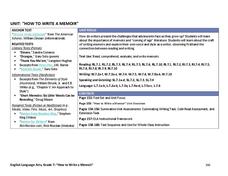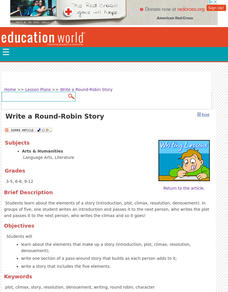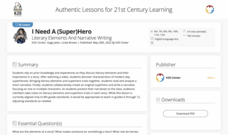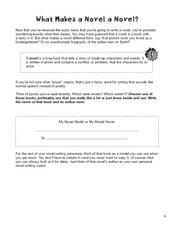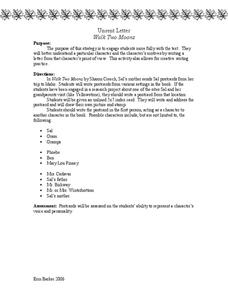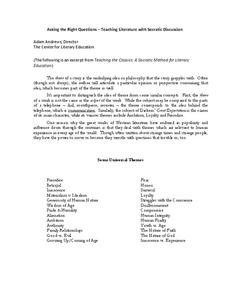Curated OER
Illustrating the Elements of a Story
Explore the elements of a story with this two-page graphic organizer. Readers write and draw descriptions of each element, including setting, plot, conflict, rising action, climax, dialogue, and narration.
PBS
Setting in To Kill a Mockingbird
Can you understand more about how a person acts by learning about how that person lives? An interactive resource explores the setting of Harper Lee's To Kill a Mockingbird with several slides discussing the location, social conditions,...
Curated OER
The News Behind the Story
What a fun way to analyze plot, setting, and character. Learners review story elements, read a short fictional story, then turn the events of that story into a headlining news paper article. Not only does this instructional activity...
Curated OER
Shizuko’s Daughter: Story Impression
Craft your own fairy tale based on Momotaro, a Japanese story referenced in Kyoko Mori's Shuzuko's Daughter. A list of nouns guide learners in writing their own story, and predicting what might happen in the novel.
Curated OER
Setting Details in Of Mice and Men
After completing John Steinbeck’s Of Mice and Men, groups are assigned a chapter to reread. Members list major conflicts and events and quote setting details. They then make observations about how the setting prepares the reader for the...
Louisiana Department of Education
How to Write a Memoir
Who are we and what shapes our identities? Seventh graders work to answer this question as they learn how to write a memoir. Full of non-print resources and supplemental texts that range from fiction to non-fiction, scholars write their...
Curated OER
Walk Two Moons: Hook and Concept of a Frame Story
As an introduction to Sharon Creexh's Walk Two Moons, a volunteer dons a pair of boots and walks about the classroom.Observers then ponder the axiom, Don't judge a man until you've walked two moons in his moccasins. Their collaborative...
Digital Public Library of America
Teaching Guide: Exploring Little Women
Louisa May Alcott's Little Women is a literary masterpiece as well as a timestamp of the formative mid-nineteenth century in America. Using a primary source set of photographs, letters, and portraits, readers discuss the ways...
Curated OER
Story Impressions-Gary Paulsen's Canyons
What is a story impression? Learn about the strategy with the first page of this two-page resource. Before reaching chapters 21-24 in Canyons, readers use a list of words (taken from these chapters) to predict what is going to happen....
Curated OER
Write a Round-Robin Story
Learners discover the elements of a story (introduction, plot, climax, resolution, denouement). In groups of five, one student writes an introduction and passes it to the next person, who writes the plot and passes it to the next person,...
Curated OER
Pudd'nhead Wilson: Writing Strategy
Assign this narrative essay after finishing Puddn'head Wilson. Learners write about their own experiences with overcoming obstacles. A five-step process is laid out on this assignment page.
Curated OER
Peter and the Starcatchers: Multi-Genre Writing Assignment
Conclude your unit on Peter and the Starcatchers with an involved final writing project that requires learners to write persuasive pieces, compose short stories, create brochures about the setting of the novel, and choose from a list of...
K20 LEARN
I Need A (Super)Hero: Literary Elements And Narrative Writing
Need a hero? Super! Groups create their modern-day marvel and craft a narrative with all the elements required in such a tale.
ReadWriteThink
Beyond the Story: A Dickens of a Party
It's time to party like it's 1899! Incorporate a research-based celebration of the Victorian Era into your unit on A Christmas Carol by Charles Dickens. After learners read the novella or view a production of the play, they craft a...
Freeology
Annotations Bookmark
In general, pupils are not allowed to write in school-issued books; however, they can write on a bookmark that you provide! Kids can take notes on the setting, characters, themes, and connections as they read a short story or novel.
Curated OER
Mystery Lessons
Learn about mysteries with your readers. They will investigate plot, basic elements of mystery, famous characters, and become familiar with genre vocabulary. Bring in props and mystery books to begin and then have learners create story...
Curated OER
What Makes a Novel a Novel?
As your authors prepare to write a hypothetical novel, they need all the inspiration they can find! Using a book they have already read (and enjoyed), learners complete a literary analysis by filling in eight short-answer questions....
Curated OER
Book Report--Mystery
Use this mystery novel activity to have learners answer several specific questions about details in the book, the atmosphere of the book, and the main characters in the book. This impressive, four-page activity will serve as an excellent...
Novelinks
Walk Two Moons: Unsent Letter
Take a journey with your class as they explore the different settings from Walk Two Moons by Sharon Creech. Middle schoolers write postcards in first person as if they were the characters of the story.
Roald Dahl
Matilda - Throwing the Hammer
Full truth, or an exaggeration? How can you tell when a storyteller is exaggerating a story? Readers analyze a story told by Hortensia, and identify the exaggerative language she uses. Then, learners write their own narrative story using...
Writing Educators Symposium
Asking the Right Questions
It can be difficult to find the theme of a book or story if you don't know the questions to ask. Teach your kids to discern the universal theme in works of literature with a set of activities that promote critical thinking and active...
Novelinks
Words by Heart: Guided Imagery
Sad, depressed, miserable, inconsolable, forlorn: so many synonyms have a lot of variety with their connotations. Through the guided imagery activity, writers explore the use of connotation and its influence on imagery and description by...
Curated OER
The Importance Setting and Mood in Fiction
Seventh graders examine the setting in pieces of fiction. In this story analysis lesson, 7th graders investigate the setting in fictional stories and the importance it has. Students discover new vocabulary terms applying to storytelling.
Curated OER
"Knot" the Whole Truth: Writing a Modern-Day Story with a Tall Tale's Voice
Beyond Paul Bunyan and his blue ox, tall tales can be a great way to teach young writers about word choice and voice in their writing. Using Jerry Spinelli's Maniac Magee and the Six-Trait Writing process, they begin to write their own...







